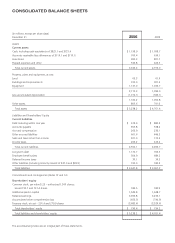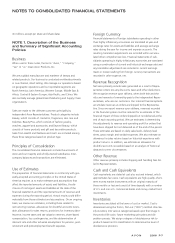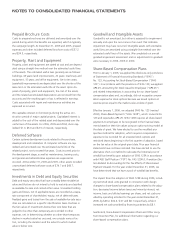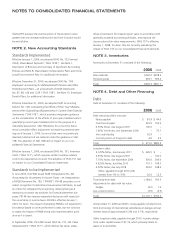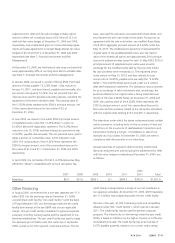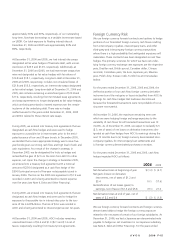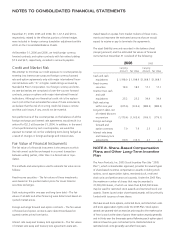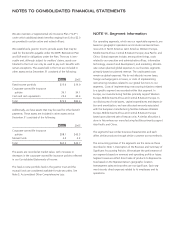Avon 2006 Annual Report Download - page 64
Download and view the complete annual report
Please find page 64 of the 2006 Avon annual report below. You can navigate through the pages in the report by either clicking on the pages listed below, or by using the keyword search tool below to find specific information within the annual report.
NOTES TO CONSOLIDATED FINANCIAL STATEMENTS
The effective tax rate for the years ended December 31 was as
follows:
2006 2005 2004
Statutory federal rate 35.0% 35.0% 35.0%
State and local taxes, net of
federal tax benefit .1 .8 .6
Taxes on foreign income,
including translation (.5) (1.9) (4.4)
Tax audit settlements, refunds,
amended returns and foreign
tax credits (5.7) (10.5) (2.8)
Repatriation of foreign earnings 3.1 – –
Permanent investment of foreign
earnings – – (1.7)
Other (.2) .6 1.1
Effective tax rate 31.8% 24.0% 27.8%
At December 31, 2006, we had foreign operating loss carryfor-
wards of approximately $833.0. The loss carryforwards expiring
between 2007 and 2021 are $97.6 and the loss carryforwards
which do not expire are $735.4. We also had minimum tax
credit carryforwards of $19.2 which do not expire and capital
loss carryforwards of $11.0 that will expire in 2010.
NOTE 7. Financial Instruments and Risk
Management
We operate globally, with manufacturing and distribution facili-
ties in various locations around the world. We may reduce our
exposure to fluctuations in cash flows associated with changes in
interest rates and foreign exchange rates by creating offsetting
positions through the use of derivative financial instruments.
Since we use foreign currency-rate sensitive and interest-rate
sensitive instruments to hedge a certain portion of our existing
and forecasted transactions, we expect that any gain or loss in
value of the hedge instruments generally would be offset by
decreases or increases in the value of the underlying
transactions.
We do not enter into derivative financial instruments for trading
or speculative purposes, nor are we a party to leveraged
derivatives. The master agreements governing our derivative
contracts generally contain standard provisions that could trigger
early termination of the contracts in certain circumstances,
including if we were to merge with another entity and the cred-
itworthiness of the surviving entity were to be “materially weak-
er” than that of Avon prior to the merger.
Accounting Policies
Derivatives are recognized on the balance sheet at their fair val-
ues. When we become a party to a derivative instrument, we
designate the instrument as either a fair value hedge, a cash
flow hedge, a net investment hedge, or a non-hedge. The
accounting for changes in fair value (gains or losses) of a
derivative instrument depends on whether it has been des-
ignated by Avon and qualifies as part of a hedging relationship
and further, on the type of hedging relationship.
• Changes in the fair value of a derivative that is designated as a
fair value hedge, along with the loss or gain on the hedged
asset or liability that is attributable to the hedged risk are
recorded in earnings.
• Changes in the fair value of a derivative that is designated
as a cash flow hedge are recorded in accumulated other
comprehensive loss (“AOCI”) to the extent effective and
reclassified into earnings in the same period or periods during
which the transaction hedged by that derivative also affects
earnings.
• Changes in the fair value of a derivative that is designated as a
hedge of a net investment in a foreign operation are recorded
in foreign currency translation adjustments within AOCI to the
extent effective as a hedge.
• Changes in the fair value of a derivative not designated as a
hedging instrument are recognized in earnings in other
expense, net on the Consolidated Statements of Income.
Realized gains and losses on a derivative are reported on the
Consolidated Statements of Cash Flows consistent with the
underlying hedged item.
We assess, both at the hedge's inception and on an ongoing
basis, whether the derivatives that are used in hedging trans-
actions are highly effective in offsetting changes in fair values or
cash flows of hedged items. Highly effective means that cumu-
lative changes in the fair value of the derivative are between
80% – 125% of the cumulative changes in the fair value of the
hedged item. The ineffective portion of the derivative’s gain or
loss, if any, is recorded in earnings in other expense, net on the
Consolidated Statements of Income. We include the change in
the time value of options in our assessment of hedge effective-
ness. When we determine that a derivative is not highly effective
as a hedge, hedge accounting is discontinued. When it is prob-
able that a forecasted transaction will not occur, we discontinue
hedge accounting for the affected portion of the forecasted
transaction, and reclassify gains and losses that were accumu-
lated in AOCI to earnings in other expense, net on the Con-
solidated Statements of Income.
Interest Rate Risk
Our long-term, fixed-rate borrowings are subject to interest rate
risk. We use interest rate swaps, which effectively convert the
fixed rate on the debt to a floating interest rate, to manage our
interest rate exposure. At December 31, 2006 and 2005, we
held interest rate swap agreements that effectively converted


